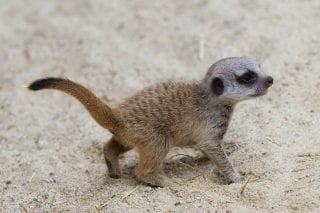Fun facts
Desert dwellers
Meerkats are well adapted to living in the harsh desert environment. They get all the moisture they need from the insects and grubs they eat. They have dark patches around their eyes. These patches cut down on glare from the sun. They also have a special covering on their eyes that protects them from dirt and dust while they are digging their burrows .
Nose to the ground
Meerkats have very sensitive noses that are adept at turning over soil and sniffing out food.
Toxic tastes
Meerkats have a daring diet that includes venomous scorpions and snakes.
Sentry Duty
Adult meerkats take turns acting as a guard, keeping an eye out for predators while the others look for food. The meerkat ‘guard’ climbs to the highest point they can find, stands upright on two legs, and then announces the beginning of guard duty with a specialized call. If a predator is spotted, the guard alerts the others with a bark or whistle so that they can then run to their burrows for safety.



